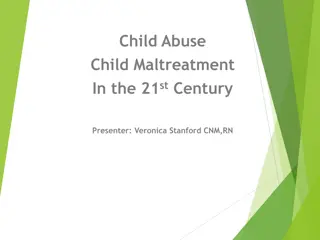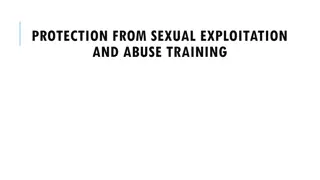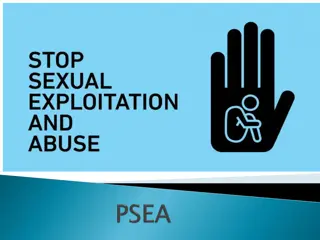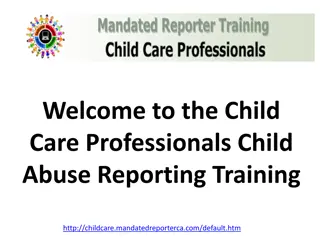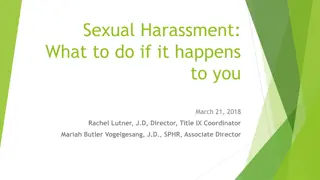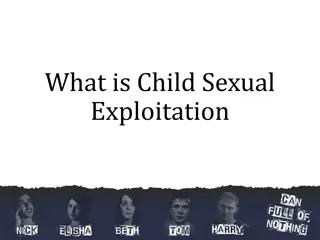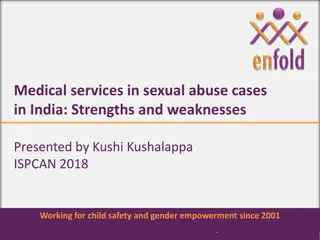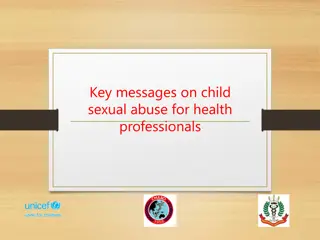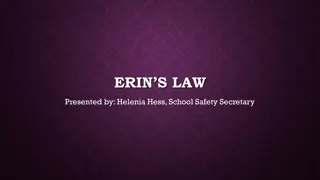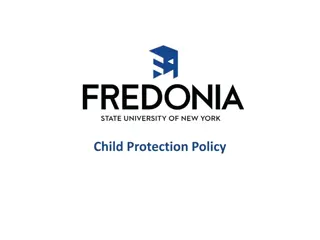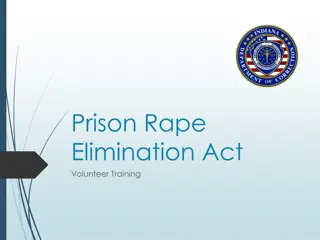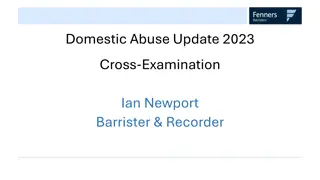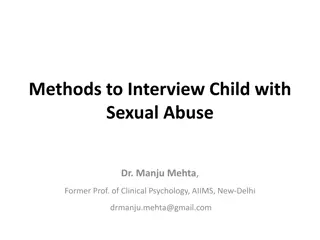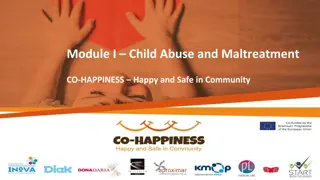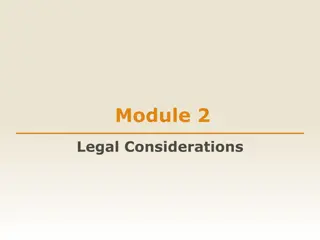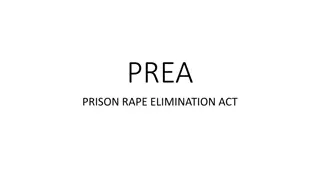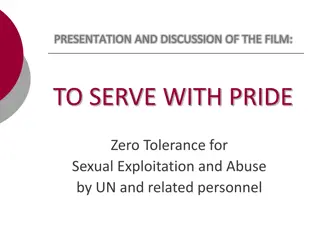Understanding the Dynamics of Child Sexual Abuse
Exploring the preconditions for sexual abuse against children, including motivation, conscience, opportunity, and resistance. The model developed by David Finkelhor sheds light on how abusers move from thoughts to actions, highlighting the importance of societal factors and the abuser-victim relationship. Overcoming internal barriers and societal norms, potential abusers navigate complex motivations and rationalizations before targeting victims. The significance of prevention strategies and understanding offender behaviors is emphasized.
Download Presentation

Please find below an Image/Link to download the presentation.
The content on the website is provided AS IS for your information and personal use only. It may not be sold, licensed, or shared on other websites without obtaining consent from the author. Download presentation by click this link. If you encounter any issues during the download, it is possible that the publisher has removed the file from their server.
E N D
Presentation Transcript
Upstream PART 3: How does it happen?
1 HOW DOES IT HAPPEN? Four pre-conditions to abuse THOUGHTS When working with those who commit sexual offences against children, the Lucy Faithfull Foundation uses a model devised by American sociologist David Finkelhor. MOTIVATION CONSCIENCE OPPORTUNITY RESISTANCE One reason why this model is helpful, is that it does not consider the abuser s actions in isolation, but also incorporates factors such as the victim and their family as well as social and cultural factors. 4 This perspective clearly places responsibility with the abuser, but also explores opportunities for others to act and potentially prevent abuse. 3 2 Earlier, we looked at some of the practical and psychological barriers that an abuser may face. Now we will see how the abuser might overcome those barriers, to go from thoughts to actions. 1 Adapted from: D Finkelhor Child Sexual Abuse: New Theory & Research 1986
1 HOW DOES IT HAPPEN? 1. MOTIVATION THOUGHTS Simply having a thought about sexually abusing a child is not the same as wanting to do it. Some OCD sufferers are plagued with thoughts that they might harm a child, yet they have no desire to do it. MOTIVATION CONSCIENCE OPPORTUNITY RESISTANCE The potential abuser must have a desire to act they expect to gain something from the abuse, such as: Enjoying degradation Feeling of power or control Meeting emotional needs Sexual gratification Motivation may be particularly high if the act holds great importance for the potential abuser (e.g. they know of no other way to meet their needs) or if they feel confident that they could carry it out. The abuser may not fully understand their own urges, what they represent or where they come from. Adapted from: D Finkelhor Child Sexual Abuse: New Theory & Research 1986
1 HOW DOES IT HAPPEN? 2. CONSCIENCE ( Internal Inhibitors ) THOUGHTS Most of us know, at some level, that sexual abuse poses a risk of serious harm to children. This is reinforced by strong cultural taboos against child sex. MOTIVATION CONSCIENCE OPPORTUNITY RESISTANCE Potential abusers must overcome their own conscience that may inhibit their motivation to abuse. Those who abuse children may use denial consciously or unconsciously to maintain their sense of themselves as a good person. Common denial tactics include: Minimisation: I am not harming the child I am making the child feel special Rationalisation: The law is wrong Other people feel or act as I do It happened to me Projection: The child is in control of me The child wants this Adapted from: D Finkelhor Child Sexual Abuse: New Theory & Research 1986
1 HOW DOES IT HAPPEN? Once they have overcome their own conscience, the potential abuser needs to start involving other people. They need to identify a potential victim, and overcome anything that may be protecting them. THOUGHTS MOTIVATION CONSCIENCE The legal and social consequences of being caught out are immense. If a potential offender decides to act on their urges, they are taking a huge risk. OPPORTUNITY RESISTANCE Most sexual offenders do not want to be caught, so the offence often involves deliberate action carried out over a period of time. Opportunistic stranger attacks do occur, but as we have seen in Part 1 and Part 2, they are rare. In these cases, a child is more likely to resist, disclose and be believed. If an offender wants to get away with their crime, they are much more likely to target a child they already know. Adapted from: D Finkelhor Child Sexual Abuse: New Theory & Research 1986
1 HOW DOES IT HAPPEN? 3. OPPORTUNITY ( External Inhibitors ) THOUGHTS The first act in the offence is creating opportunity . MOTIVATION This is easy, if the potential abuser is often left alone with an unsupervised child. They may seek ways to do this as much as possible, including putting themselves in a position of trust. CONSCIENCE OPPORTUNITY RESISTANCE Otherwise, the potential abuser may need to build trust in the child s parents or other protective adults. We cannot always supervise our children, and we often need to rely on adults we hope we can trust, such as: Family especially spouses / partners and close relatives Friends Respected Professionals teachers, youth leaders, police, doctors, nurses, therapists Adapted from: D Finkelhor Child Sexual Abuse: New Theory & Research 1986
1 HOW DOES IT HAPPEN? 4. VICTIM RESISTANCE THOUGHTS Finally, the potential abuser has to overcome the child's possible resistance to being sexually abused. MOTIVATION CONSCIENCE Lower resistance means the abuser has more chance of getting away with the act and being free to do it again. Abusers report that they can almost instinctively pick out a vulnerable child while ignoring those who might resist. They may coerce the child into keeping a secret through: OPPORTUNITY RESISTANCE Grooming Confusing the child Intimidation Bribery or flattery Threats Blaming the child Abuse can also result from force, threat of harm and violence. In these cases, no matter how much resistance the child displays, it may not prevent the abuse. Adapted from: D Finkelhor Child Sexual Abuse: New Theory & Research 1986
1 HOW DOES IT HAPPEN? What does this tell us? It can be terrifying to think about the huge amount of calculation, deception and manipulation that may be involved in committing a sexual offence against a child. However, there is value in educating ourselves about this. Because most abusers want to get away with their offences: - - We can raise our children to be confident, open and honest, and thus less attractive targets for a potential abuser We can educate ourselves on the signs of somebody attempting to lower a child s resistance to abuse such as buying excessive gifts, or keeping secrets We can be aware of signs that somebody is trying to create opportunities to be alone with a child - Because many abusers still want to believe they are good people: - - - We can show that we do not tolerate sexualisation of children We can challenge someone if they exhibit behaviour or attitudes that trouble us We can support positive interventions, such as help for those who want to address their thoughts and urges In the next chapter, we look at some practical tips for identifying and responding to warning signs of abuse


